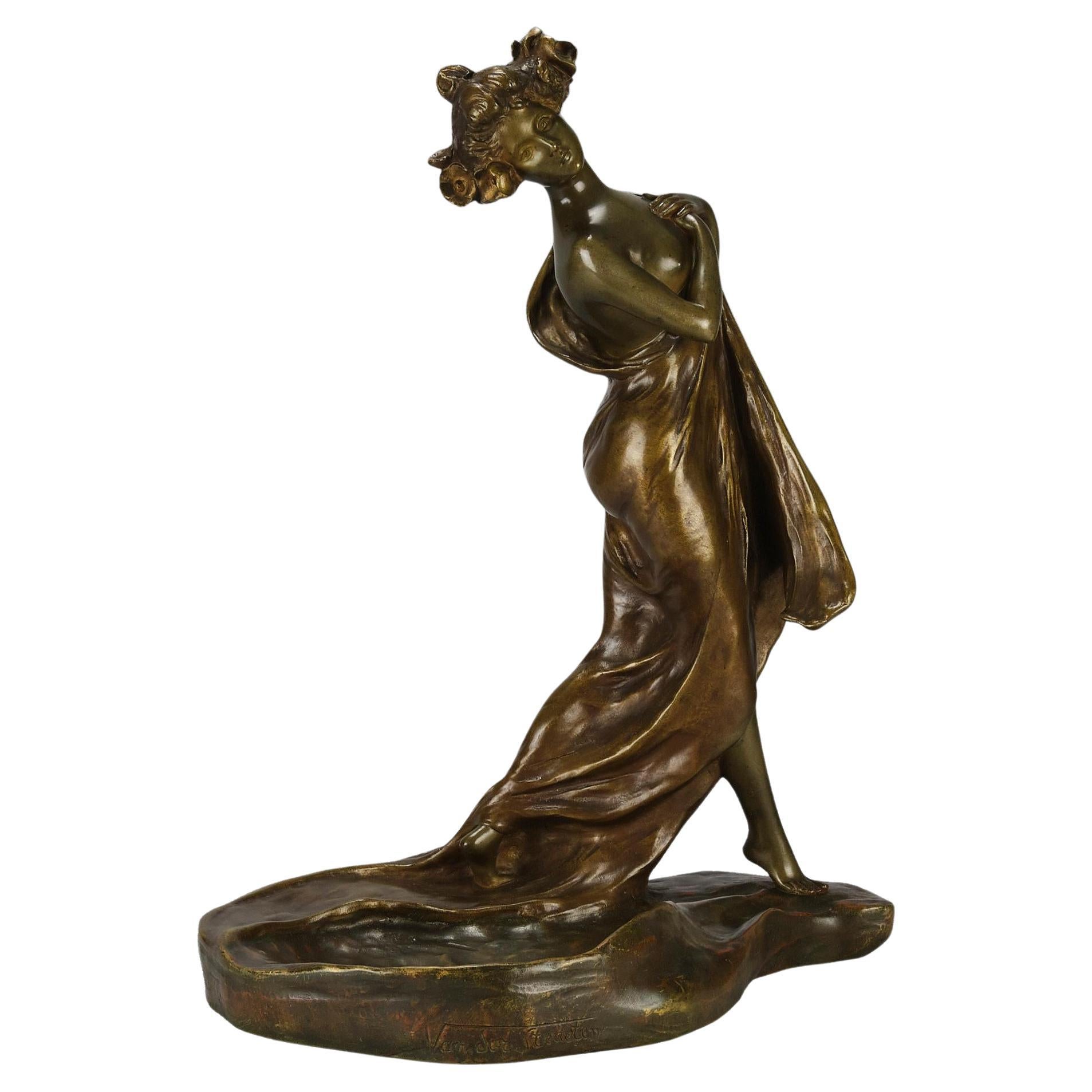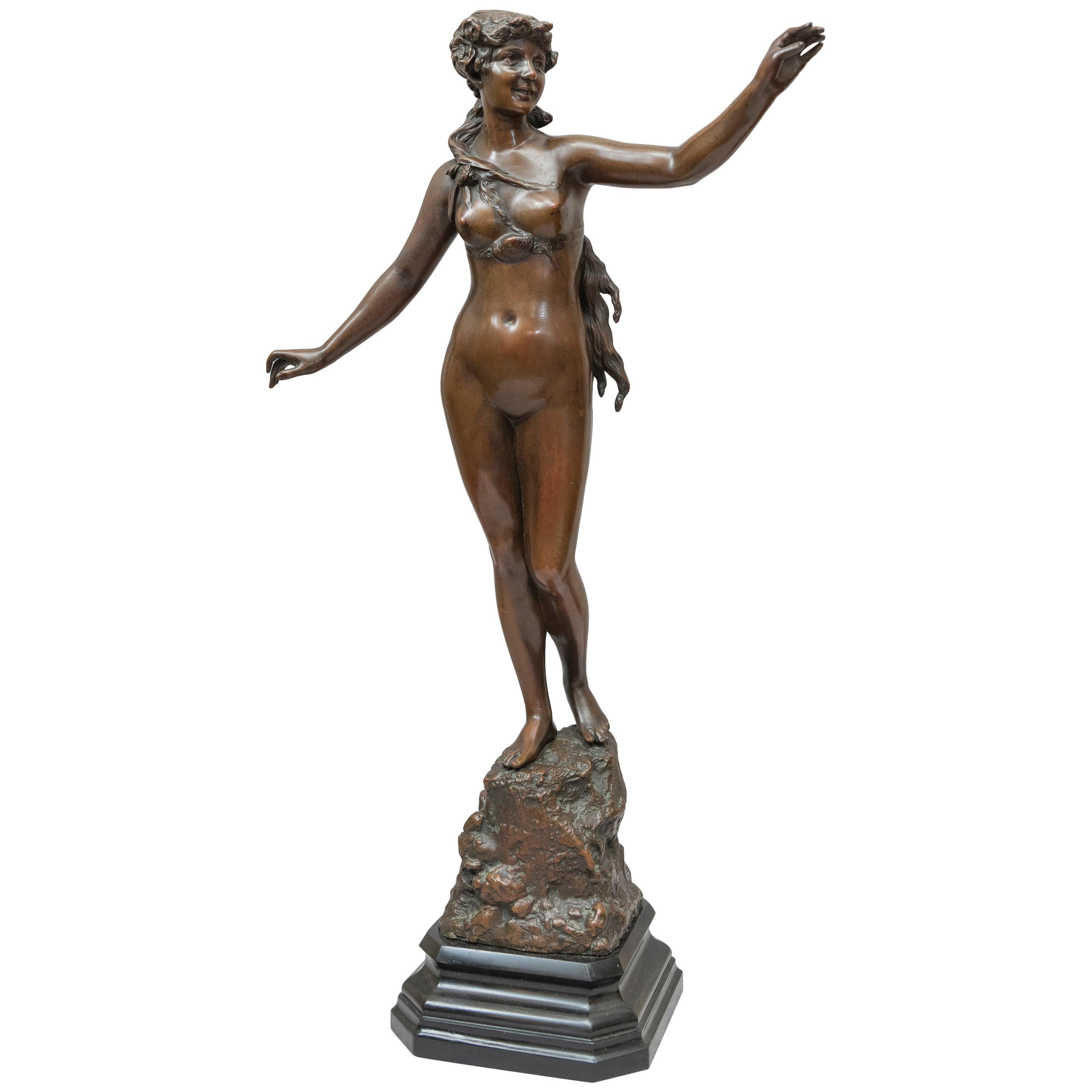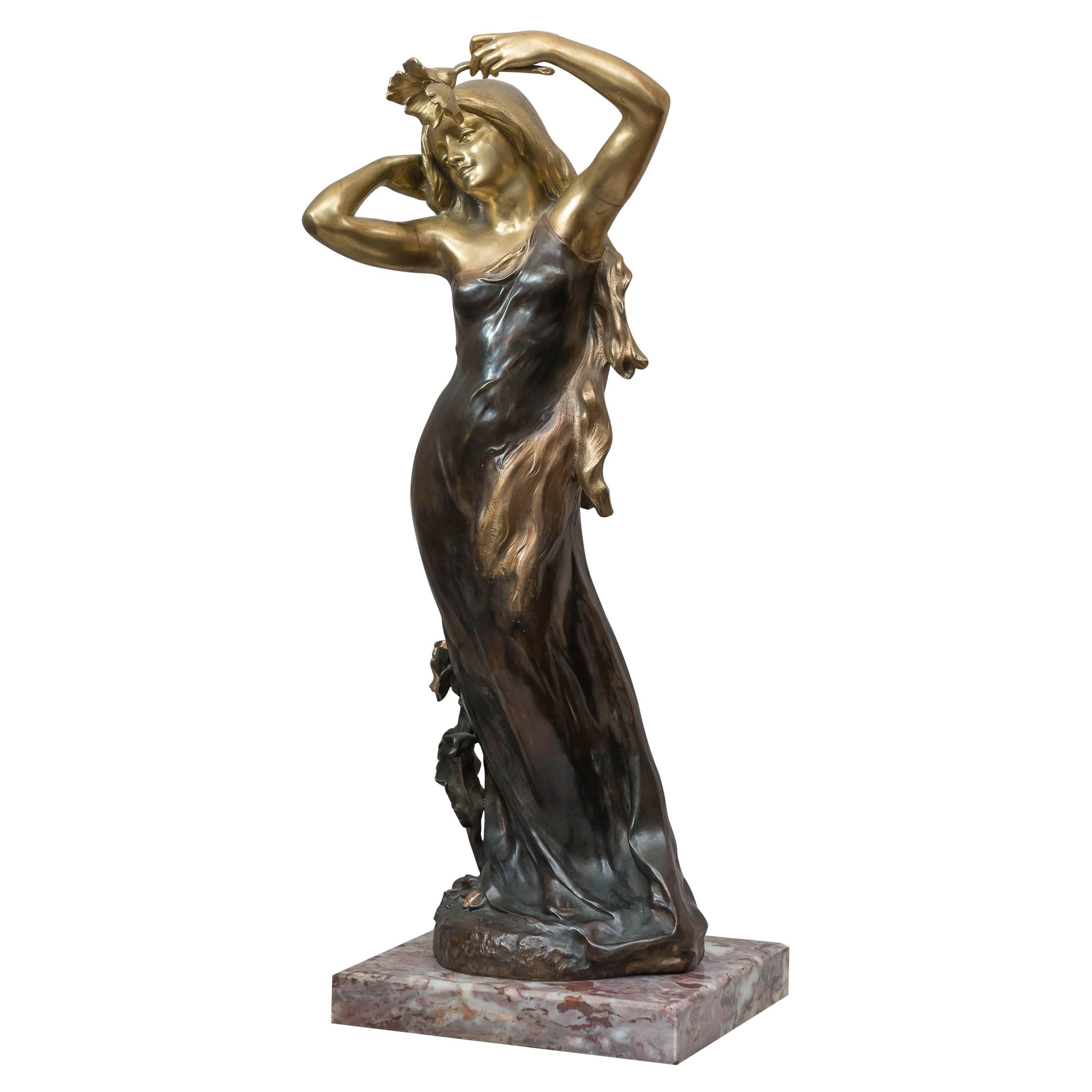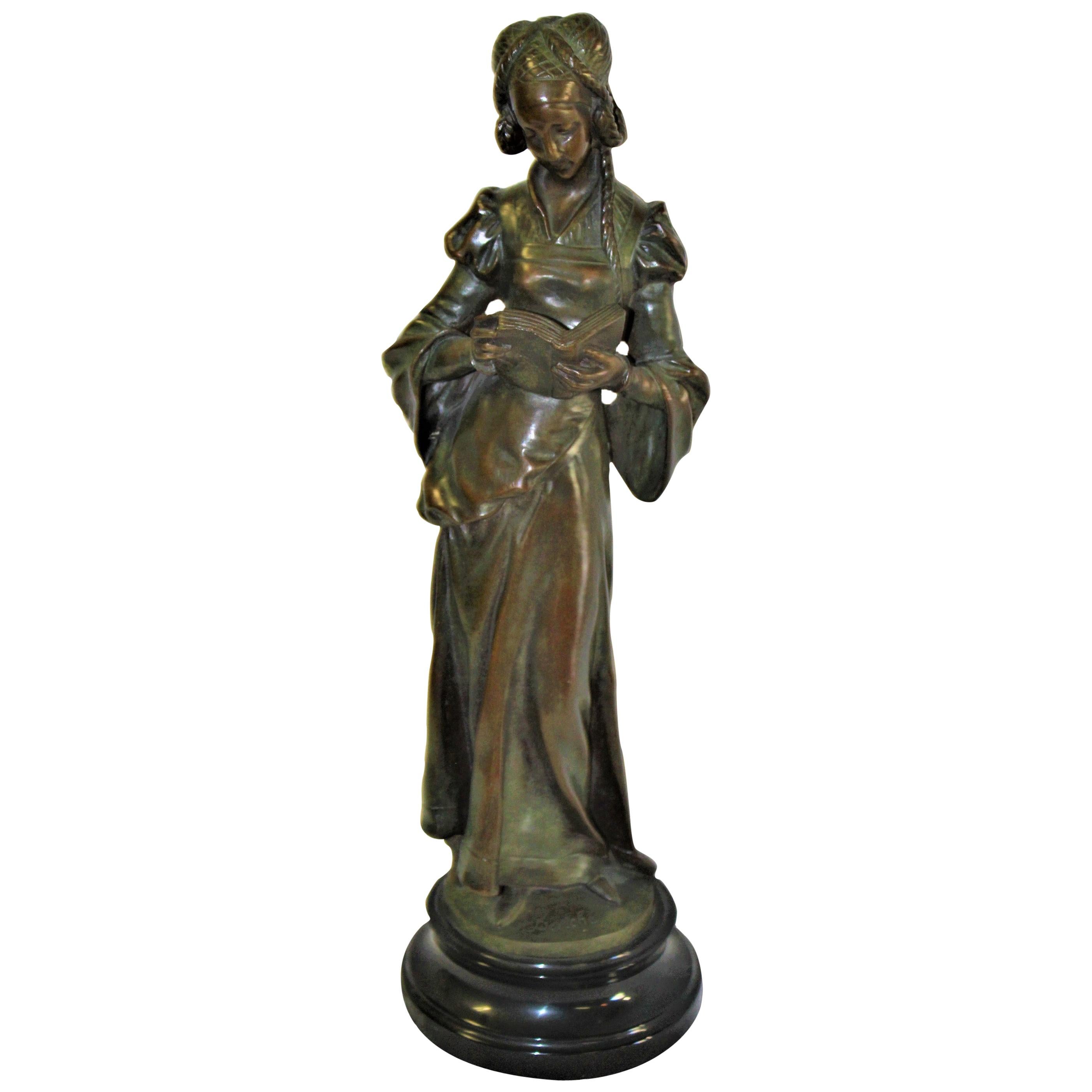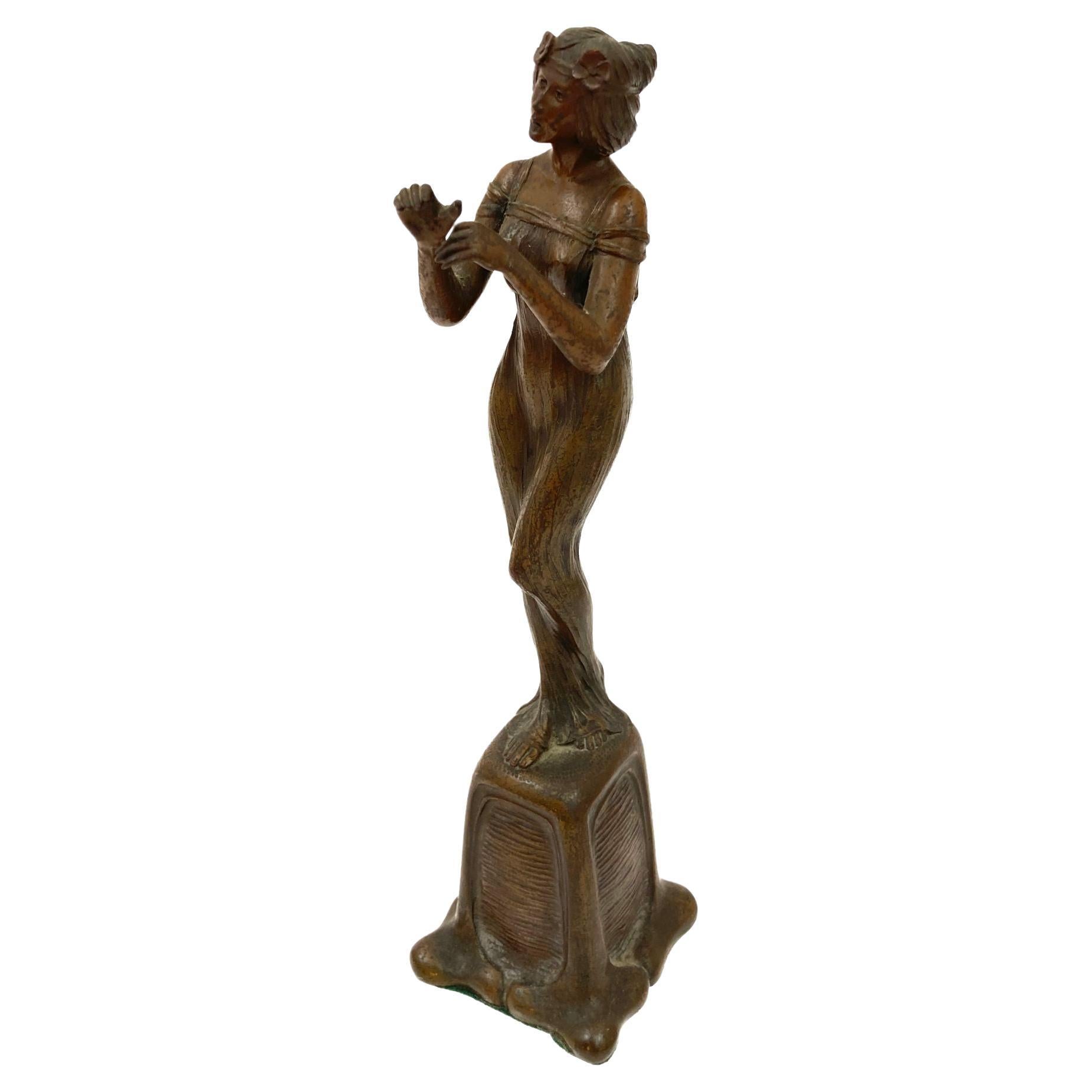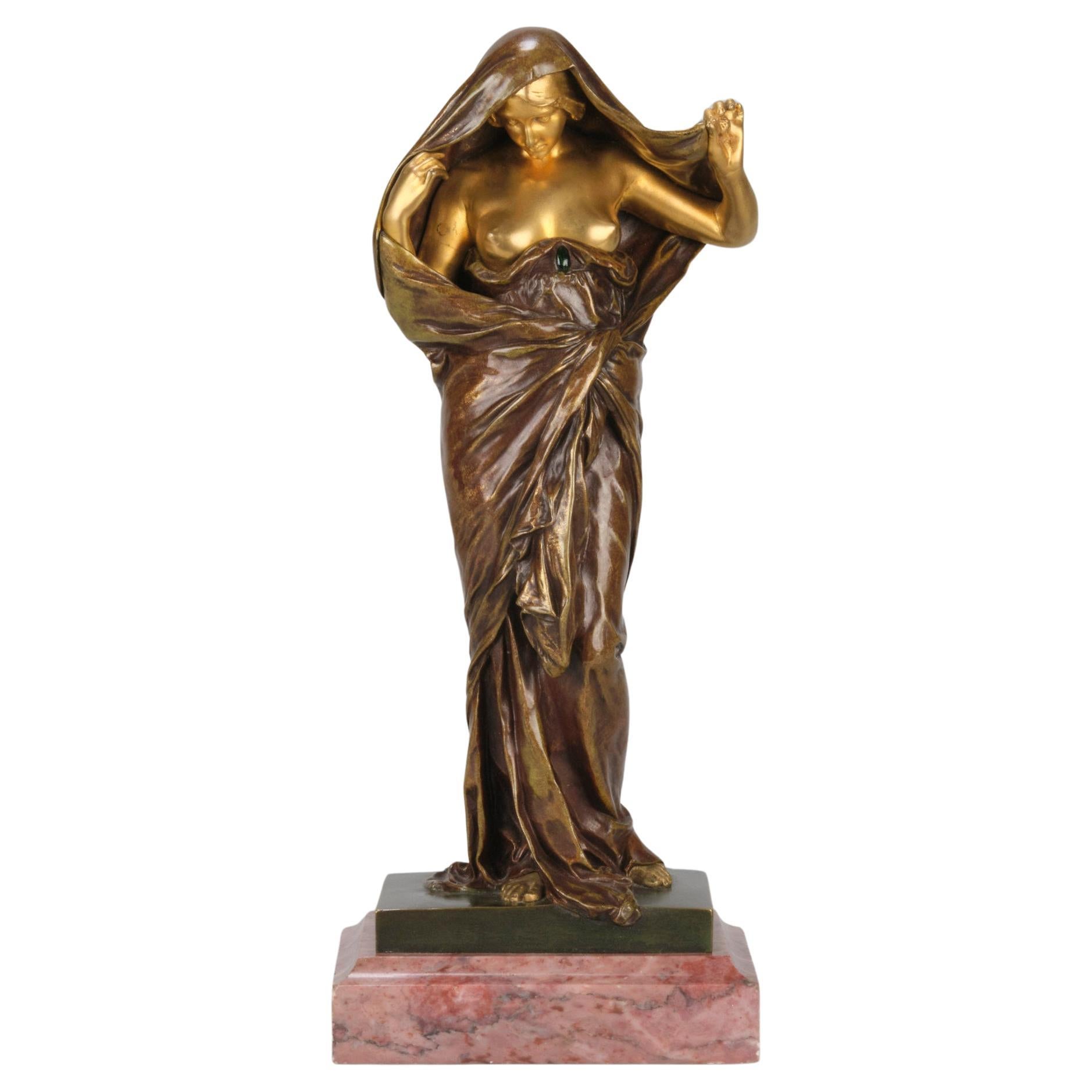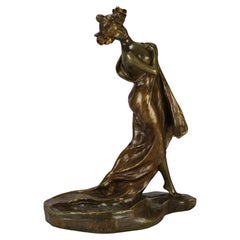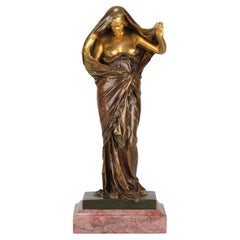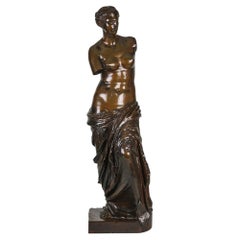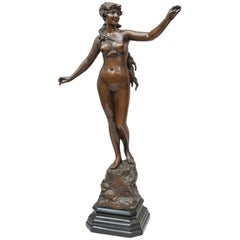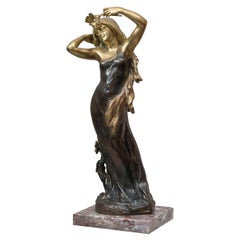Items Similar to Late 19th Century Art Nouveau Sculpture "Girl in Cloak" by Vernon March
Want more images or videos?
Request additional images or videos from the seller
1 of 13
Late 19th Century Art Nouveau Sculpture "Girl in Cloak" by Vernon March
$2,311.23
£1,675
€1,976.13
CA$3,205.79
A$3,495.01
CHF 1,846.70
MX$42,980.44
NOK 22,962.20
SEK 21,615.87
DKK 14,752.18
About the Item
An excellent late 19th Century patinated Art Nouveau bronze study of a naked beauty standing on a podium with a cape draped over her shoulders, raised on a marble plinth and signed
ADDITIONAL INFORMATION
Height: 31 cm
Diameter: 10 cm
Condition: Excellent Original Condition
Circa: 1890
Materials: Cold Painted Bronze
Book Ref Antique Vienna Bronzes by Joseph Zobel
SKU: 9377
ABOUT
Vernon March (1891–1930) was a British sculptor renowned for his monumental works commemorating war heroes. Born in Kingston upon Hull, he moved to London with his family, where he became the youngest exhibitor at the Royal Academy of Arts at age 16 with his sculpture "Psyche" . Despite lacking formal training, March's talent led to significant commissions, including the Cape Town Cenotaph, the Samuel de Champlain Monument in Ontario, and the Diamond War Memorial in Derry. His most notable work, the National War Memorial of Canada, was completed posthumously by his siblings after his death from pneumonia at 38 .
- Dimensions:Height: 12.21 in (31 cm)Diameter: 3.94 in (10 cm)
- Style:Art Nouveau (Of the Period)
- Materials and Techniques:
- Place of Origin:
- Period:
- Date of Manufacture:1890
- Condition:Wear consistent with age and use.
- Seller Location:London, GB
- Reference Number:Seller: 93801stDibs: LU3216345326062
About the Seller
5.0
Vetted Professional Seller
Every seller passes strict standards for authenticity and reliability
Established in 1936
1stDibs seller since 2017
84 sales on 1stDibs
Typical response time: <1 hour
- ShippingRetrieving quote...Shipping from: London, United Kingdom
- Return Policy
Authenticity Guarantee
In the unlikely event there’s an issue with an item’s authenticity, contact us within 1 year for a full refund. DetailsMoney-Back Guarantee
If your item is not as described, is damaged in transit, or does not arrive, contact us within 7 days for a full refund. Details24-Hour Cancellation
You have a 24-hour grace period in which to reconsider your purchase, with no questions asked.Vetted Professional Sellers
Our world-class sellers must adhere to strict standards for service and quality, maintaining the integrity of our listings.Price-Match Guarantee
If you find that a seller listed the same item for a lower price elsewhere, we’ll match it.Trusted Global Delivery
Our best-in-class carrier network provides specialized shipping options worldwide, including custom delivery.More From This Seller
View AllLate 19th Century Art Nouveau Bronze "Nouveau Lady" by Georges Van Der Straeten
By Georges Van der Straeten
Located in London, GB
A delightful Art Nouveau Bronze figure of a young beauty scantily dressed with only a shawl draped across her body in a striking pose. The surface of the bronze with rich golden/brow...
Category
Antique Late 19th Century Belgian Art Nouveau Figurative Sculptures
Materials
Bronze
Late 19th Century Art Nouveau Sculpture "Nature Unveiling" by Ernst Barrias
Located in London, GB
Wonderful late 19th Century Art Nouveau French bronze figure of a seductively draped female figure representing, in allegorical form, Nature revealing her secrets to Science, a fitti...
Category
Antique Late 19th Century French Art Nouveau Figurative Sculptures
Materials
Marble, Bronze
Late 19th Century Art Nouveau Sculpture "Venus de Milo" by F. Barbedienne
By F. Barbedienne Foundry
Located in London, GB
A large and impressive late 19th Century bronze study of the famous Venus de Milo sculpture of antiquity with excellent rich brown patina and good hand finished surface detail, inscribed F.Barbedienne foundry
ADDITIONAL INFORMATION
Height: 95 cm
Width: 28 cm
Depth: 28 cm
Condition: Excellent Original Condition
Circa: 1890
Materials: Bronze
Foundry: F.Barbedienne
SKU: 7741
ABOUT
The Barbedienne Foundry is a famous 19th century bronze foundry, whose statues and art objects became rapidly very renowned. This bronze studio co-worked with other trades, and put his name to a great variety of works, such as furnishing in particular. Attending every World's Fair of its time, the Barbedienne Foundry was regularly awarded, notably at the World's Fair of 1855 where it was awarded the Great Medal of Honor.
A Parisian bronze maker and caster, Ferdinand Barbedienne (1810-1892) creates a firm in 1839 in collaboration with Achille Collas, the inventor of the mechanical method to obtain copies of sculptures at a smaller scale. With this groundbreaking proceed, they facilitated an unprecedented production. Under the “Collas et Barbedienne” name, they specialized in Antiquity copies and perfected new chemical methods for the color and patina finish of their bronzes. As a true Romantic, Ferdinand Barbedienne is committed to democratization of arts, he thus realizes numerous Antiquity copies and stimulates his contemporaries’ works broadcasting. A great deal of famous sculptures are hence cast by the Barbedienne Foundry. All his life, Barbedienne co-worked with the greatest artists, sculptors or designers of his time, such as Edouard Lievre, Ferdinand Levillain, Attarge, Aizelin, Barye or Fremiet.
Statues aside, he products a great deal of decorative artifacts, such as clocks, vases, mirrors, etc. Since 1855, Ferdinand Barbedienne collaborates with the famous decoration designer Louis-Constant Sévin (1821-1888). Joining the firm as a sculptor-designer, he stays loyal to it his life long, always finding more new designs for daily objects, which hence become true art works. Sevin’s creations, specialized in the “Neo-Greek” style, were particularly appreciated for antiquity reference in decorative arts, just like the great mirror preserved by the Orsay Museum. He also teams up with enamelers including Alfred Serre, and develops a set of “cloisonnés” enamels that made the headlines at the World's Fair of 1862 in London, which was the very beginning of the art of enamel’s return. In collaboration with Serre, Barbedienne realized between 1878 and 1889 the Monumental Clock in Renaissance style, decorated with enamels, which is preserved in the Paris City Hall.
Venus de Milo
Facts about Venus de Milo sculpture.
For much of the world, the mystery of the Venus de Milo lies in her missing arms. But there’s much more to this iconic statue than a couple of absent appendages.
1. Venus de Milo‘s title is a bit misleading.
It’s popularly believed that this Grecian statue depicts the Greek Goddess of love and beauty, who was often rendered half-naked. However, the Greeks would have called this deity Aphrodite. Nonetheless, the Roman-inspired Venus de Milo caught on.
2. She’s named in part for where she was discovered.
On April 8, 1820, a farmer named Yorgos Kentrotas came across the statue in pieces within the ruins of an ancient city on the island of Milos (formerly known as Melos).
3. Alexandros of Antioch is credited with her creation.
A sculptor of the Hellenistic period, Alexandros is believed to have carved this masterpiece between 130 and 100 BCE. The inscription on the plinth—the slab on which the statue rested—that identified him as Venus de Milo‘s creator was lost nearly 200 years ago.
4. She might not be Venus.
Some have suggested the sculpture is not Aphrodite/Venus, but Amphitrite, the sea goddess who was particularly adored on Milos. Still others have proposed she’s Victory, or perhaps a prostitute. With her arms long missing, would-be context clues have been lost for centuries. A spear could have meant one thing, a spool of thread another. If she held an apple—as some reports claim—it could mean she was Aphrodite, holding the award given to her by Paris before the Trojan War began. To this day, it’s a matter of passionate debate.
5. She became a gift to the King of France.
When Kentrotas called upon a French naval officer to help him unearth the spectacular sculpture, he began a chain of events that would eventually lead to the Marquis de Rivière presenting Venus de Milo to Louis XVIII. In turn, the ruler gave the statue to the Louvre, where it is on display to this very day.
6. The loss of her limbs is the fault of the French.
Kentrotas did find fragments of an arm and a hand when he uncovered the statue in the ruins, but as Venus de Milo was being reassembled, those arms were discarded for having a “rougher” appearance. Modern art historians believe that the variation of finish does not mean those arms did not belong to Venus, but both the arms and the original plinth have been lost since the piece moved to Paris in 1820.
7. The original plinth was ditched on purpose.
Sight unseen, early 19th century art historians decided the newly discovered Venus must have been the work of Greek artist Praxiteles, and publicized the work as such. This attribution would have placed the piece in the Classical period (5th through 4th centuries BCE), which was more respected artistically than the Hellenistic period. To save face and better promote Venus de Milo—even at the cost of misinforming the public—the plinth was removed before it was presented to the King.
8. Venus de Milo was meant to make up for a national embarrassment.
During his conquests, Napoleon Bonaparte had plundered one of the finest examples of Greek sculpture, Venus de’ Medici, from Italy. In 1815, the French government returned that beloved sculpture, but in 1820, France embraced the chance to fill the hole its absence left in the French culture and national pride. As such, Venus de Milo was promoted as being even greater than Venus de’ Medici upon her Louvre debut. The ploy worked, and the piece was met with almost universal praise from artists and critics.
9. Renoir was not impressed.
Perhaps the most famous of Venus de Milo‘s detractors, the celebrated Impressionist painter dismissed this delicate depiction of grace and female beauty as “a big gendarme.”
10. She went into hiding during World War II.
By the autumn of 1939, war threatened to descend on Paris, so Venus de Milo along with some other priceless pieces, such as Winged Victory of Samothrace and Michelangelo’s Slaves, were whisked away for safekeeping at various châteaux in the French countryside.
11. She’s been robbed!
Venus is missing more than just her arms. She was originally draped in jewellery including a bracelet, earrings and a headband. These flourishes are long lost, but the holes for fixing them to the piece remain in the marble, giving clues to the missing accessories.
12. She lost her colour.
While it’s easy for today’s art admirers to think of Greek statues as white, the marble was often painted in the style of polychromy. However, no trace of the original paint scheme remains on Venus de Milo today.
13. She’s taller than most people.
Even with her slight slouch, Venus de Milo stands at 6 feet 8 inches tall.
14. She could be a copy.
Art historians have noted that Venus de Milo bears a striking resemblance to Aphrodite of Capua, which is a Roman era copy of a possibly late 4th century BCE bronze Greek original. That would be at least 170 years before Alexandros carved his goddess, leading some to speculate that both statues are actually replicas of an older statue...
Category
Antique Late 19th Century French Art Nouveau Figurative Sculptures
Materials
Bronze
Early 20th Century Art Nouveau Bronze Entitled "La Jeuneuse" by Antonin Carlès
By Antonin Carlès
Located in London, GB
A delightful Art Nouveau early 20th Century gilt bronze figure of a very beautiful young lady holding a flower in her right hand, the surface of the bronze exhibiting fine detail and...
Category
Antique Early 1900s French Art Nouveau Figurative Sculptures
Materials
Bronze
Early 20th Century Bronze Sculpture entitled "Cloaked Lady" by Josef Lorenzl
By Josef Lorenzl
Located in London, GB
An attractive early 20th Century Art Deco cold painted bronze figure of an elegant beauty dropping a cloak thats draped across her shoulders. The bronze exhibiting excellent colour a...
Category
Early 20th Century Austrian Art Deco Figurative Sculptures
Materials
Marble, Bronze
Late 19th Century Bronze Sculpture entitled Femme avec Oiseau by Maurice Bouval
By Maurice Bouval
Located in London, GB
A fabulous Art Nouveau bronze figure of a young beauty sat upon a rock surrounded by birds whilst holding a lute with excellent colour and very fine hand chased surface detail, raise...
Category
Antique 19th Century French Art Nouveau Figurative Sculptures
Materials
Bronze
You May Also Like
Art Nouveau Bronze Figure of Nude Maiden, German, circa 1900
By Berndorfer Metallwarenfabrik
Located in Petaluma, CA
Offering here an antique bronze figure of a nude maiden, signed Berndorf. Berndorf was a German foundry started in the mid-19th century. The figure is richly patinated in a warm brow...
Category
Early 20th Century German Art Nouveau Figurative Sculptures
Materials
Marble, Bronze
$1,180 Sale Price
60% Off
Art Nouveau Bronze Figure of a Young Woman
By Henryk Kossowski Jr. 1
Located in Petaluma, CA
For the art nouveau lover, this is certainly worth one to ponder, for all others, here is fine example art nouveau. The two color patina makes this very desirable. Her beautiful gold...
Category
Antique 1890s French Art Nouveau Figurative Sculptures
Materials
Marble, Bronze
$1,925 Sale Price
65% Off
Art Nouveau Bronze Lady, Marble Base 'The book Lady'
Located in Los Angeles, CA
A fine detailed bronze casting of an elegant lady in full dress reading a book. Hence the title is (The book Lady) lost wax casting in multi-patina mount...
Category
1990s North American Art Nouveau Figurative Sculptures
Materials
Bronze
Bronze Figure of an Art Nouveau Young Women circa 1900
By Victor Heinrich Seifert
Located in Moreno Valley, CA
Bronze Figure of an Art Nouveau young woman.
circa 1900.
Beautiful European Art Nouveau Bronze Sculpture of a young woman.
This beautifully made German style bronze sculpture of a yo...
Category
Early 20th Century German Art Nouveau Figurative Sculptures
Materials
Bronze
Paul Philippe ( 1870-1930) Art Nouveau Sculpture in Bronze, Signed on Marble
By Paul Philippe
Located in Saint-Ouen, FR
Paul Philippe (1870-1930) Art Nouveau sculpture in bronze, signed on marble.
Category
Early 20th Century European Art Nouveau Figurative Sculptures
Materials
Marble, Bronze
'La Sémeuse', Large Art Nouveau Bronze Figure After Oscar Roty, Vienna, Ca 1899
By Hans Schörk
Located in Vienna, AT
A young woman in a long dress with short sleeves, softly enveloping her body, with a scarf covering her hair and falling well over her face to protect her from the burning sun, walking across the field at a leisurely pace, holding out her apron with the seeds spread out in front of her with her left hand and making a sweeping gesture with her right.
On a narrow, elongated natural plinth with rounded corners, with the artist's signature ‘Schork 99’ incised on the side, as well as the Goldscheider manufactory's pressed stamp, pressed model number and incised monogram ‘AH’ on the back behind the figure.
This motif is particularly well known in France, where it adorned all French franc coins and postage stamps for many years and was continued in a stylised form on all cent coins of the euro after 2001.
Louis Oscar Roty (1846 - 1911) This sower is very familiar to the French: she was depicted on the fifty-centime coin and on the one-, two- and five-franc coins until 2001, when a stylised version of her appeared on the ten-, twenty- and fifty-centime coins of the euro. The figure dates back to 1887, when Roty designed a prize medal for the Ministry of Agriculture, a project that was not pursued. When the Minister of Finance commissioned new coins in 1896, Roty was among the selected artists. He drew on the Sower of 1887, but transformed his robust farmer into a slender Marianne, who wore the Phrygian cap of freedom. The traditional profile of the Republic was abandoned in favour of a more active, standing figure. This effigy was criticised, but generally very well received: ‘The seeds she generously throws into the earth are the countless ideas that may one day germinate and flourish when we are no longer here’ (La Liberté, 8 October 1898). The gesture is more symbolic than realistic – we do not sow against the wind, which nevertheless makes the hair behind the sower flutter – but it makes the composition more dynamic. Originally, ‘The Sower’ was used on the fifty-centime to two-franc coins introduced in 1897 and 1898, before appearing on postage stamps in 1903. It is thus the most widely circulated work of art in France. Although not included in the Musée d'Orsay's medal collection, this wax drawing on slate, typical of the technique of a medallist, is one of the most beautiful pieces and demonstrates the virtuosity of Roty. (Musée d'Orsay, The Collections)
Design by HANS SCHORK...
Category
Antique Early 1900s Austrian Art Nouveau Figurative Sculptures
Materials
Bronze
More Ways To Browse
Royal Academy Of Arts
Used Furniture Vernon
Atlas Titan
Auguste Moreau Spelter
Bas Relief Portrait
Blanc De Chine Figures
Bronze Cowboy
Bronze Czech Sculpture
Bronze Harlequin
Bronze Water Carrier
Bronze Wrestlers
Brutalist Man Sculpture
Buddha Head On Stand
Capodimonte Cherub
Carrera Sculpture
Carved Stone Woman
Demon Sculpture
E Drouot
